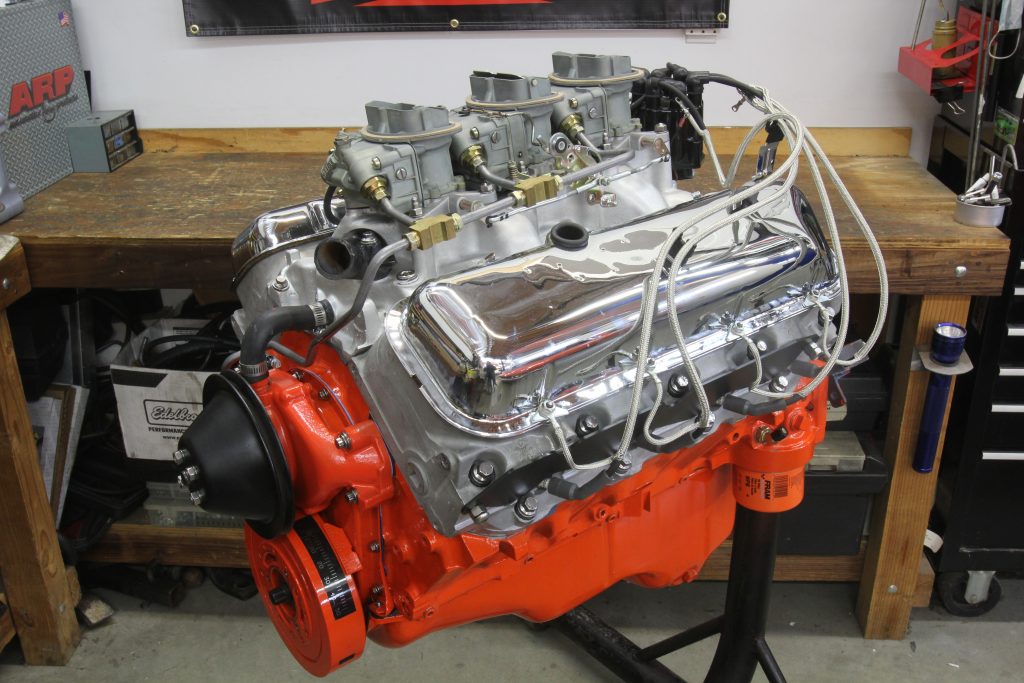I’m going to have someone build a street engine for me and I want to use 1968 round port Corvette 400 hp Tri-Power manifold and carbs using one inch spacers. With a single plane intake manifold and an 850 cfm Holley carburetor, the engine made over 600 lb.-ft. for torque and 600 hp. The engine currently has a hydraulic cam and almost 10:1 compression. How will the Tri-Power set up with vacuum secondaries work? Will this affect the power and drivability?
I had a couple ‘67 427 Corvettes a long time ago. I had a good mechanic, they always worked well, and I loved the look! I appreciate your thoughts. Thanks.
L.C.

I’ve never seen a comparison of this manifold against a good single four-barrel, single plane intake manifold but my guess is that while you will have plenty of airflow with the three carburetors, that is not where the restriction in airflow will occur. The manifold will be the restriction since it will really does not come close due to the tight port turns the manifold requires the air and fuel to make. If I had to hazard a guess, the manifold will easily cost 25 hp over a good tall single plane intake and an 800 cfm carburetor.
Manifold height is one of the keys.
I did a single plane manifold dyno test a number of years ago for Car Craft. This literally became a test of manifold carb mounting height. As the height of the carb mounting plate rose vertically above the manifold floor, the power went up because the air did not have to make an abrupt change in direction entering the cylinder head. The one inch spacers for the Tri-Power manifold will help only slightly. The problem is that manifold is nearly flat between the manifold floor and the port entry. That makes the air have to perform this sharp, 90 degree turn—which causes the air and fuel to tumble, creating flow restrictions.
I don’t think this manifold/tri-power carb package will hurt drivability as long as the camshaft is not too big. Try to keep the idle manifold vacuum at or above 11 inches and this will really help off-idle throttle response. Don’t be tempted to use a big camshaft with low idle vacuum. These cams just kill the low-speed response making the engine fell soggy and unresponsive and no fun to drive.
Chart: Carb Height vs. Power
The chart below represents a test of three Edelbrock small block Chevy single plane manifolds all tested on the same engine. While there are several reasons for the differences in power, the most important factor was the height of the carb mounting pad relative to the floor of the manifold.
Carburetor Height vs. Power
| Intake Manifold | Carb Height | Avg. Torque | Peak Horsepower |
|---|---|---|---|
| Edelbrock Torker II | 3.38" | 460 ft.-lbs. | 492 |
| Edelbrock Victor Jr. | 3.91" | 479 ft.-lbs. (+19) | 532 (+40) |
| Edelbrock Super Victor II | 4.05" | 491 ft.-lbs. (+31) | 549 (+57) |
As you can see from the chart, torque and horsepower improved as manifold height grew. In this particular case, we were using a 400ci small block Chevy that was capable of 550 hp. The Carb Height value is the distance between the carburetor mounting pad and the plenum floor in inches. The difference between the Torker II and Super Victor II is almost 0.75 inch and was worth 57 hp.
The Super Victor II is also a much different design that also plays into this power improvement so you can’t just assume that adding a carb spacer to the Torker II will help to the tune of 50 because that will not be the case—but height does matter!

Barudan@suddenlinkmail.com
I need a contact phone number for two sway bars to be heat treated . We are building a GT 40 MK iv
DAVID GUADAGNOLI
318-623-0622
considering this ebay engine and use a 69 oval port tri power 342 gears 70 chevelle with th350 372544463714 oval port intake and stock unmodified carbs, looking for good tire smokin low end power overall drivability and maybe a blast down the strip occasionally but mostly streets driving